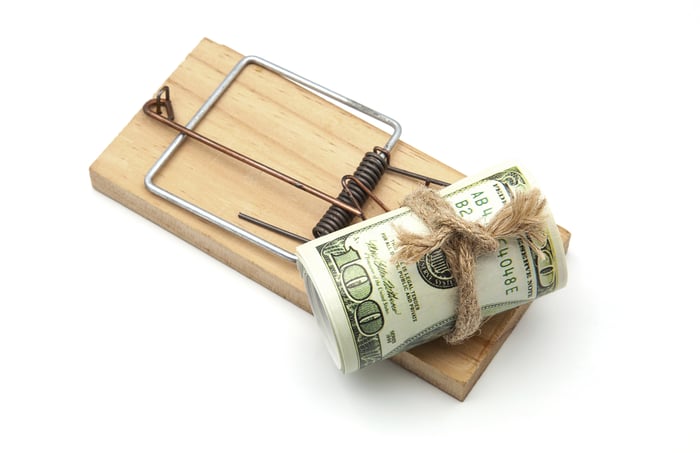Best Stock to Buy Right Now: British American Tobacco vs. Kraft Heinz
If you like high-yield investments you've probably had both British American Tobacco (NYSE: BTI) and Kraft Heinz (NASDAQ: KHC) pop up on your stock screens. There are things to like about each one, things to dislike, and one major difference that should lead investors to a clear choice between them.
Here's what you need to know and why the lower-yielding stock is probably the better choice for most investors.
Start Your Mornings Smarter! Wake up with Breakfast news in your inbox every market day. Sign Up For Free »
British American Tobacco bests Kraft Heinz on the dividend front
If you focus exclusively on the dividend, the best choice here is British American Tobacco. That starts with the yield. British American Tobacco is providing investors with an 8.4% dividend yield. Kraft Heinz's dividend yield is a much lower 5.5%. Sure, that's relatively high compared to the S&P 500 index, which is only yielding 1.2%, and the average consumer staples stock, which is yielding 2.8%, but it is clearly nowhere near as attractive on an absolute basis as 8.4%.

Image source: Getty Images.
There's also a big difference between the dividend track records of Kraft Heinz and British American Tobacco. Kraft Heinz cut its quarterly dividend in 2019 from $0.625 per share to $0.40 per share and the payment hasn't grown since. British American Tobacco's quarterly dividend has been trending steadily higher, in the British company's home currency, since it started paying quarterly dividends in 2018.
If all you care about are dividends, the obvious choice here is British American Tobacco. But dividends alone do not provide the full picture.
Business is rough for Kraft Heinz and British American Tobacco
The lofty dividend yields on offer from these two consumer staples companies exist because they are each dealing with business problems. This is where most investors should be focusing their attention if they intend to hold either of these stocks for the long term.
Kraft Heinz was created via the merger of Kraft and Heinz. The food maker's original goal was to cut costs to improve profits. That isn't a great long-term business approach and pretty quickly a new direction was needed.
Now, after a management overhaul, the company is focusing on growing its most important brands and trying to sell off brands that aren't as meaningful to the top and bottom lines. This is an approach that has worked well for a number of other companies, but it is slow going for Kraft Heinz right now. In fact, the brands the company has been focusing on have been doing worse than the brands it isn't focusing on.
No shock, the stock has been in a funk and the yield is high. But given the success competitors like Procter & Gamble and Unilever have had with the same approach, it seems likely that Kraft Heinz will muddle through this rough patch given enough time.
British American Tobacco's problems run much deeper. The company's primary product is cigarettes. The company's cigarette volumes have been falling for years. To put some numbers on that, in 2018 the company produced roughly 700 billion cigarettes. That number was down to 555 billion in 2023. And while full-year 2024 figures aren't available yet, the number is likely to have fallen again given the continued weakness in volumes in the first half of the year.
British American Tobacco has been offsetting the ongoing volume declines with ongoing price increases. But that can only last so long before price increases exacerbate the volume declines.
In fact, British American Tobacco has even changed the way it accounts for its U.S. cigarette brands. While a bit arcane, it is basically treating the brands as if they will be worthless in roughly 30 years. That's not a great sign for the future and hints at the deep underlying troubles the company is facing, even though the stock has risen more than 15% in the past year.
Neither is great, but one is probably better
The ugly truth is that neither British American Tobacco nor Kraft Heinz is doing particularly well today from a business perspective. Conservative dividend investors will probably want to tread carefully with both companies.
But if you are choosing between them, Kraft Heinz seems like it is the better opportunity. After all, nobody needs to smoke a cigarette, but everyone does need to eat food. Given the strong brands Kraft Heinz controls, it seems more likely that it will get back on track compared to British American Tobacco, where its most important brands could be heading toward obsolescence.
Should you invest $1,000 in British American Tobacco right now?
Before you buy stock in British American Tobacco, consider this:
The Motley Fool Stock Advisor analyst team just identified what they believe are the 10 best stocks for investors to buy now… and British American Tobacco wasn’t one of them. The 10 stocks that made the cut could produce monster returns in the coming years.
Consider when Nvidia made this list on April 15, 2005... if you invested $1,000 at the time of our recommendation, you’d have $818,587!*
Stock Advisor provides investors with an easy-to-follow blueprint for success, including guidance on building a portfolio, regular updates from analysts, and two new stock picks each month. The Stock Advisor service has more than quadrupled the return of S&P 500 since 2002*.
See the 10 stocks »
*Stock Advisor returns as of January 13, 2025
Reuben Gregg Brewer has positions in Procter & Gamble and Unilever. The Motley Fool recommends British American Tobacco P.l.c., Kraft Heinz, and Unilever and recommends the following options: long January 2026 $40 calls on British American Tobacco and short January 2026 $40 puts on British American Tobacco. The Motley Fool has a disclosure policy.
